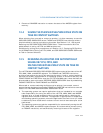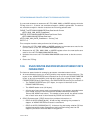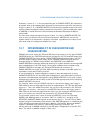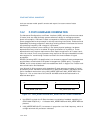
Vol. 3 13-17
SYSTEM PROGRAMMING FOR INSTRUCTION SET EXTENSIONS AND
13.8 DETECTION, ENUMERATION, ENABLING PROCESSOR
EXTENDED STATE SUPPORT
An OS can determine if the XSAVE/XRSTOR/XGETBV/XSETBV instructions and the
XFEATURE_ENABLED_MASK register (XCR0) are available in the processor by
checking the value of CPUID.1.ECX.XSAVE to be 1. The OS must set CR4.OSXSAVE to
1 to enable the new instructions. The OS uses XSETBV to enable the processor state
component (setting the corresponding bit in XCR0 to 1) that it will manage using
XSAVE/XRSTOR. Bit 0 of XCR0 must be set to 1. The value of CR4.OSXSAVE is
reflected in CPUID.01H:ECX.OSXSAVE (bit 27) to communicate the setting to non-
privileged software.
The bits that must be enabled in the XFEATURE_ENABLED_MASK register (XCR0)
and the size of the memory region needed to save processor extended state informa
-
tion must be enumerated by CPUID leaf 0DH with ECX = 0 as input. However, the
recommended usage by system software to use XSAVE/XRSTOR is to:
• Allocate a memory buffer according to the size reported by CPUID.(EAX=0DH,
ECX=0H):ECX. The value reported by CPUID.(EAX=0DH, ECX=0H):ECX always
includes the size of the header. Clear the entire buffer prior to being used by
XSAVE.
• Provide EDX:EAX with all bits set to 1 for XSAVE and XRSTOR instructions.
An alternative approach is to read the master bit vector mask EDX:EAX reported by
CPUID.(EAX=0D, ECX=0H). This mask may be used as input to the XSAVE/XRSTOR
Figure 13-3. OS Enabling of Processor Extended State Support
Check
HW support XSAVE, XRSTOR, XSETBV, XFEM
CPUID.1H:ECX.XSAVE?
Enumerate
Extended state features
Buffer size requirement
Set valid bits in
XCR0 via XSETBV
Set CR4.OSXSAVE
to 1
Clear buffer to 0
XSETBV enabled


















